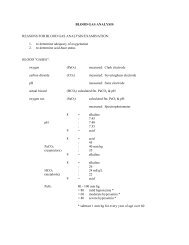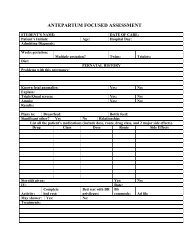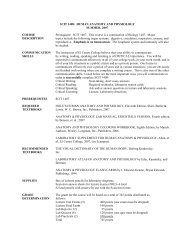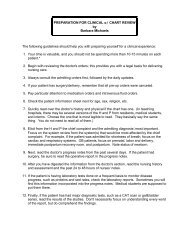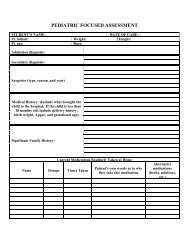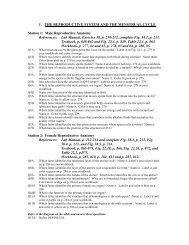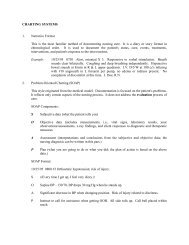Lab Manual, Exercise 35, p. 192-193 an
Lab Manual, Exercise 35, p. 192-193 an
Lab Manual, Exercise 35, p. 192-193 an
Create successful ePaper yourself
Turn your PDF publications into a flip-book with our unique Google optimized e-Paper software.
9. THE URINARY SYSTEM AND URINALYSISStation 1: Org<strong>an</strong>s of the Urinary SystemReferences: <strong>Lab</strong> <strong>M<strong>an</strong>ual</strong>, <strong>Exercise</strong> <strong>35</strong>, p. <strong>192</strong>-<strong>193</strong> <strong>an</strong>d complete Fig. <strong>35</strong>.1, p.<strong>192</strong>.Textbook, p. 792-793 <strong>an</strong>d 816-820 <strong>an</strong>d Fig 20.1, p. 793.Workbook, p. 263, #1, p. 264, #2, p. 271, #16, <strong>an</strong>d p. 272, #17.On the model of the urinary org<strong>an</strong>s:Q1A. The kidneys are located behind the parietal peritoneum against the deep muscles of the back.What word describes this location?Q1B. What holds the kidneys in place?Q2A. Which letter identifies a structure made of tr<strong>an</strong>sitional epithelium that exp<strong>an</strong>ds <strong>an</strong>d contracts withurine volume? Name it. Name the tube that removes urine from it. Which letter identifies thetube?Q2B. Which letter identifies a structure that receives urine from the kidneys <strong>an</strong>d tr<strong>an</strong>sports it byperistalsis? Name it. What is its exp<strong>an</strong>ded upper end called?Station 2: Kidney AnatomyReferences: <strong>Lab</strong> <strong>M<strong>an</strong>ual</strong>, p. <strong>193</strong> <strong>an</strong>d complete Fig. <strong>35</strong>.2, p. <strong>193</strong>.Textbook, p. 792-793 <strong>an</strong>d Fig. 20.4, p. 795.Workbook, p. 265, #3 <strong>an</strong>d p. 266, #4.Q3A. Which letter identifies the fibrous connective tissue layer that protects the kidney? Name it.Color it purple on Fig. 15-2, p. 265 in your workbook.Q3B.Q4A.Q4B.Q5A.Q5B.Q6A.Q6B.What is found on the outside of the layer in Q3A that further protects <strong>an</strong>d supports the kidney?The kidney is divided into two areas. Which letter identifies <strong>an</strong> area that is richly supplied withblood vessels to feed the nephrons that are forming urine? Name it. <strong>Lab</strong>el this area <strong>an</strong>d color ityellow on Fig. 15-2, p. 265.Extensions of the area named in Q4A extend down into the other area of the kidney, separating itsparts. Which letter identifies these extensions? Name them <strong>an</strong>d color them yellow also on Fig.15-2.Which letter identifies the inner area of the kidney? Name it. Why does this area appear striated?Which letter identifies cone-shaped masses that fill the area in Q5A? Name them. Color themor<strong>an</strong>ge on Fig. 15-2, p. 265. What is found at their tip?Which letter identifies short tubes that carry away urine to be removed from the body? Namethem. Color them blue on Fig. 15-2, p. 265.Which letter identifies the funnel-shaped collecting chamber that drains urine into the ureter?Name it. Color it pink on Fig. 15-2, p. 265.On the Preserved Kidney:Observe the preserved kidney. The same letters are used to identify the structures named in Q4a-6b. Makesure you c<strong>an</strong> identify these structures on models <strong>an</strong>d the preserved kidney.Station 3: The NephronReferences: <strong>Lab</strong> <strong>M<strong>an</strong>ual</strong>, p. 194 <strong>an</strong>d complete Fig. <strong>35</strong>.3, p. 194.Textbook, p. 796-802 <strong>an</strong>d Fig. 20.10, p. 799.Workbook, p. 266, #5.On the nephron model:Q7A. Which letter identifies the structure where filtration occurs? Name it. <strong>Lab</strong>el it on Fig. 15-3, p. 267in your workbook.
Q7B.Q8A.Q8B.Q9A.Q9B.The structure in Q7A is made of two parts, one contributed by the circulatory system <strong>an</strong>d one thatis a part of the nephron. What two letters identify these parts? Name them. Color the circulatorypart red <strong>an</strong>d the nephron part pink on Fig. 15-3, p. 267.The nephrons in the kidney may be divided into two groups. About 80% of them belong to onegroup. Name this group. Which letter on the lab table identifies a nephron of this group?The other group of nephrons is import<strong>an</strong>t in regulating water bal<strong>an</strong>ce in the body. Name thisgroup. Which letter on the lab table identifies a nephron of this group?The remainder of the nephron is composed of renal tubule. The renal tubule is divided into threeparts. Name these parts. What three letters identify them on the lab table? <strong>Lab</strong>el them on Fig. 15-3, p. 267.Once the urine leaves the nephron it enters a tubule which runs through the medulla of the kidney.Which letter identifies this tubule on the lab table? Name it. Color it or<strong>an</strong>ge on Fig. 15-3, p. 267.Station 4: Urine FormationReferences: <strong>Lab</strong> <strong>M<strong>an</strong>ual</strong>, p. 194-195.Textbook, p. 802-815.Workbook, p. 269, #7 <strong>an</strong>d #8.Q10A. Urine formation consists of three processes: filtration, reabsorption, <strong>an</strong>d secretion. Which letteridentifies the part of the nephron where filtration occurs? Name it. Draw purple arrows on p. 267in your workbook to indicate the direction of filtration.Q10B. What is the fluid produced as a result of filtration called? What structure does it drain into?Which letter identifies this structure on the model?Q11A. What system described in your text regulates filtration? What structure controls this by sensingthe concentration of sodium in the nephron fluids?Q11B. Most tubular reabsorption occurs in one part of the renal tubule. Which part is it? Which letteridentifies it on the model? On Fig. 15-3, p. 267, draw blue arrows between the structure younamed <strong>an</strong>d the peritubular capillaries surrounding the nephron to indicate the direction ofreabsorption.Q12A. Which letter on the model shows where potassium ions may be secreted into urine? Name thisstructure. What hormone controls the secretion of potassium? Draw green arrows on p. 267 toshow the direction of secretion between the structure you named <strong>an</strong>d the peritubular capillariessurrounding the nephron.Q12B. The structure named in Q12A is also affected by a hormone that controls water bal<strong>an</strong>ce in thebody. Name this hormone. From what gl<strong>an</strong>d is it produced?Q13A. Which letter on the model identifies a structure that is responsible for the countercurrentmech<strong>an</strong>ism? Name it. What does the countercurrent mech<strong>an</strong>ism regulate?Q13B. One of the main secretory products of the nephron is hydrogen ions. What effect will thisconcentration of hydrogen ions have on the urine?Station 5: UrinalysisReferences:<strong>Lab</strong> <strong>M<strong>an</strong>ual</strong>, <strong>Exercise</strong> 36, p. 196-199. Study Table 36.1 <strong>an</strong>d36.2, p. 196.Textbook, p. 815-816.Workbook, p. 270, #9, #10, #11, <strong>an</strong>d #12, <strong>an</strong>d p. 271, #13 <strong>an</strong>d#14.Q14A. What is the normal r<strong>an</strong>ge for urine output for 24 hours? Name a condition that could cause this toch<strong>an</strong>ge.Q14B. What is the most abund<strong>an</strong>t org<strong>an</strong>ic product in urine, <strong>an</strong>d what is the most abund<strong>an</strong>t inorg<strong>an</strong>icproduct in urine?Q15A. What color is normal urine? What pigment gives urine this color?Q15B. What is turbidity? Is fresh, normal urine turbid?
Collect a sample of fresh urine for <strong>an</strong>alysis. Samples should be collected in the providedurine cups <strong>an</strong>d should contain about 60 ml of urine. Read the instructions for this<strong>an</strong>alysis carefully <strong>an</strong>d do not discard <strong>an</strong>y urine until you are finished with it at the end ofthe lab. When you are finished with equipment used to measure characteristics of yoururine, cle<strong>an</strong> those items with soap <strong>an</strong>d water <strong>an</strong>d sterilize them with disinfect<strong>an</strong>t spray.WEAR GLOVES DURING THIS LAB EXERCISE.Choose a sample of unknown urine from the selection on the lab table. Write the letter ofthe urine sample you use at the top of your lab report.Using a separate Multistix or Combistix for your sample <strong>an</strong>d for the unknown sample,dip the test stick into your urine. After 30 seconds, begin reading the test results. Startwith Glucose, then Bilirubin, then Ketone, Specific Gravity, blood pH, Protein,Urobilinogen, Nitrite, <strong>an</strong>d Leukocytes. Note <strong>an</strong>y abnormalities in your urine. Repeat theprocess with the unknown urine sample that you chose.Q16A: List <strong>an</strong>y areas that reported out of normal r<strong>an</strong>ge for your urine sample.Q16B: List <strong>an</strong>y areas that reported out of normal r<strong>an</strong>ge for your unknown urine sample.Q17A. Was your specific gravity normal? Concentrated urine has a (high/low) specific gravity.Q17B. Dilute urine has a (high/low) solute content <strong>an</strong>d therefore it has a (high/low) specific gravity.Q18A. What was your urine pH? How would a diet high in proteins affect urine pH?Q18B. Did your urine contain glucose? What might cause a temporary nonpathogenic appear<strong>an</strong>ce ofglucose in urine?Q19A. Did your urine contain ketones? What nutrient produces ketones when incompletely metabolized?Q19B. Did your urine contain leukocytes? Why might leukocytes appear in the urine?Return your unknown urine sample to the beginning of this station.Dispose of your personal urine sample by pouring it down the sink with lots of water.Station 6: Microscopic AnalysisYour lab instructor will operate the centrifuge for you at this station.1. Four different students should donate their urine samples (not the unknownsample) to be centrifuged. Do not attempt to operate the centrifuge yourself.After the samples have been centrifuged, a small pellet will be formed in thebottom of each test tube.2. Pour off the supernat<strong>an</strong>t (the top liquid).3. Add 1 drop of Sedistain to the test tube.4. Mix the stain by tapping the end of the test tube.5. Place 1-2 drops of the solution from the test tube onto a slide using adisposable dropper.6. Cover specimen with a cover slip <strong>an</strong>d observe the specimen under themicroscope.7. Use the Atlas on the lab table <strong>an</strong>d Fig. 36.1, p. 199 in your lab m<strong>an</strong>ual, toidentify crystals, cells, <strong>an</strong>d casts observed in the specimen.8. Throw away the disposable dropper.9. Discard your urine sample in the sink <strong>an</strong>d rinse the drain with water.10. Cle<strong>an</strong> the test tubes as directed.Q20A. Give one example of a pathogenic cause of bacteriuria.Q20B. What are CASTS?Q21: CLINICAL APPLICATION THOUGHT QUESTION: (Answer at the bottom of your lab report.)





